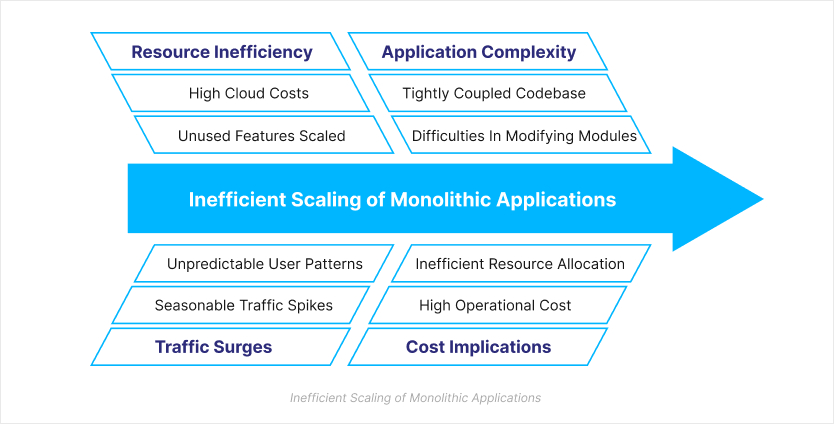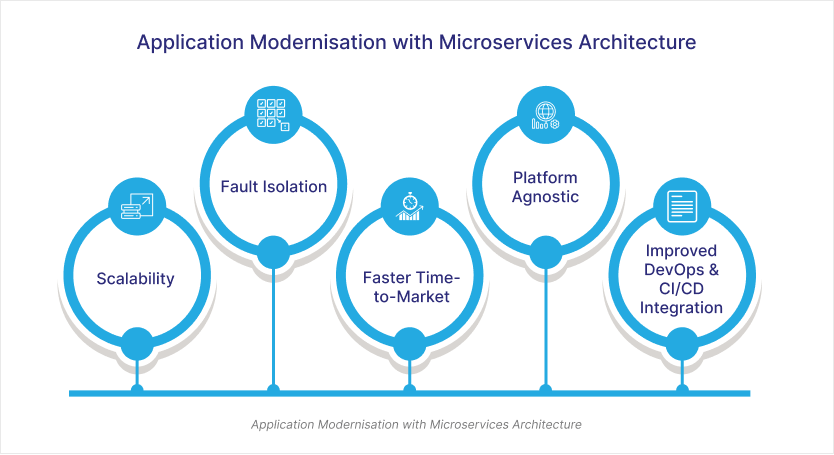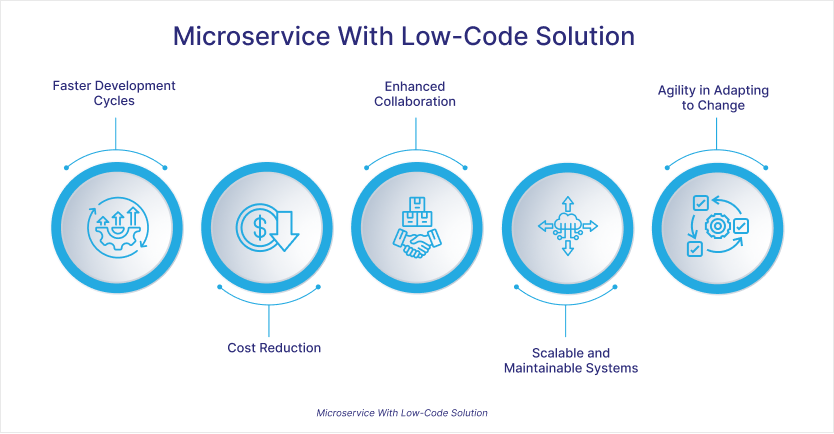Accelerating Application Modernisation: Implementing Microservices with Low-Code Solutions.
Introduction
Transforming legacy systems has always been the key focus of innovation in the tech sector. As a product of that drive, Microservice Architecture was launched to mitigate the applications from monolithic bottlenecks. However, in order to eliminate and simplify the complexity of adapting microservices, low-code development was widely preferred. This shift has not only increased efficiency but also enabled businesses to innovate faster, deploy more scalable solutions, and reduce time-to-market.
This blog breaks down the impact of the dynamic amalgamation of microservice architectures and low-code solutions that transform application modernisation. It slowly unpacks the challenges of legacy modernisation while moving to the solution—microservices architecture. Finally, it reveals the advantages of leveraging microservices in conjunction with low-code solutions.
Challenges in Legacy Modernisation

Monolithic Architecture Scalability Issues
Legacy modernisation systems involve monolithic architectures that are tightly coupled with a codebase. This can be used by startups and small-scale businesses until there arises a need to scale. It has been proven inefficient in the current scenario due to the complexity in scaling, as scaling a monolithic application often involves replicating the entire application across multiple servers to handle higher loads. It is highly resource-intensive to scale the entire application even if there’s only one part that needs scaling.
For instance, during festive seasons, a shopping application (AsapBuy) experiences a 3x surge in traffic, which forces the platform to scale. During the scaling process, even the unused features like wishlists or admin panels need to be scaled just to handle the load on the “checkout” module (the module that needs change), which results in high cloud costs.

Single Point of Failure
As monolithic architecture is a unified system, it acts as a single point of failure if there exists any malfunction in any part of the system. This is because all the functionality resides in a single codebase and is typically managed through a single deployment pipeline, infrastructure stack, or database. This type of architecture poses a threat of bringing down the entire application for a minor or lone error.
It is highly risky for applications that demand high availability and uptime to provide reliable services. Technically, it is also difficult to isolate system failures or faults due to the synthesised resource system. Therefore, the failure of one system component can have cascading effects on other parts of the application.
For instance, in the same scenario, if a bug is detected in the payment process module of the shopping application (AsapBuy), the entire application is at risk of a data breach. While addressing this issue, AsapBuy will be in downtime, which can cause significant revenue loss.
Slow Development and Release Cycles
Monolithic architecture has a long development process and release cycle due to its tightly coupled code. When a minute change of any part of the system occurs, the entire system will be obligated to redevelop or rebuild the application.
In a legacy system, large teams working on the different modules will stumble between coordinating the changes and protecting the other areas from being affected by the change, thereby challenging the testing and integration part of the development process. Furthermore, the deployment pipeline is often linear, meaning any updates require a coordinated release across the entire application. This leads to longer release cycles that prolong the time to market.
For instance, AsapBuy decides to include a new feature, ‘‘EMI’ for all products. Due to the tight coupling of the monolithic architecture, the entire application is obligated to be redeveloped. Unfortunately, as the entire team, like payment, inventory, etc., needs to coordinate to redevelop the application, it results in a delay in development time.
Limited Flexibility for Teams
Legacy (monolithic) systems require the alignment of the entire team to develop and deploy the application. Every team that works on every part of the application must coordinate with the same codebase, changes, and technology, which constrains their flexibility of innovation and work. Waiting for approvals and coordinating with all the teams for a minor change or development purpose in the application substantially delays the timeline of its development.
The tight coupling between the components means that teams often do not have the autonomy to work independently. They must coordinate their changes with other teams, which results in delays and a loss of agility. These various side effects of the legacy system’s inflexibility culminate in diminished application performance, potentially jeopardising its overall viability and long-term success.
For instance, the customer care unit wanted to add an analytical tool with an advanced ML algorithm to the application that can track and detect the customer’s preferences to enhance sales. However, the backend team refused to provide the products’ database for security reasons. This hinders the innovative advantage of the application due to the limited flexibility among the teams.
These limitations of legacy systems can be effectively mitigated through the implementation of microservice architecture, offering a robust solution to modernisation challenges.
Efficiently integrate and access business platforms and applications using Enterprise Portal.
Contact SquareOne!
Application Modernisation with Microservices Architecture
Microservice architecture offers a fundamental shift from monolithic systems by decoupling applications into independently deployable services. This approach enhances efficiency in development, deployment, and maintenance. With microservices, each service operates autonomously, communicating via lightweight protocols such as HTTP/REST or messaging queues. To enable this modular approach, modern technologies like containerisation (e.g., Docker) and orchestration tools (e.g., Kubernetes) are often employed, facilitating easy scaling and management. By isolating each function, microservices ensure that improvements or changes to one service can occur without impacting other components of the application.
This architectural type was introduced to address the issues of the monolithic structure.

Scalability
Microservices’ standalone functions are loosely coupled, which allows the application to scale without having the need to replicate the entire application. It provides sufficient resources to scale individual components according to the requirements.
In the case of AsapBuy (the shopping application), instead of scaling the entire platform, microservices enable the “checkout” module to be scaled independently without affecting unused features like wishlists or admin panels. This selective scaling method enables scalability without having to incur resources.
Fault Isolation
In a microservice environment, the faults can be isolated and fixed individually without bringing down the entire application while other services of the application work seamlessly. As it does not function under a single codebase, single deployment pipeline, infrastructure stack, or database, unlike the synthesised resource, the faults can be sorted out solely without any technical hindrance.
In the case of AsapBuy, when the bug is detected in the payment process module, only that part of the application will be redeveloped due to the solitary sets of services. This eludes the entire application from downtime and revenue loss.
Faster Time-to-Market
As separate teams govern the loosely coupled architecture, the collective focus without the concern of other teams’ development minimises the time incurred in development. The team autonomously decides the development process of each service, ultimately leading to faster deployment.
In the case of AsapBuy, the ‘EMI’ feature can be developed without redeveloping the entire application due to its modular architecture and microservice-based design. Each feature or service can be developed, updated, or deployed independently, allowing for the seamless addition of new functionalities like the EMI feature without affecting the rest of the system. This modular approach enhances flexibility, accelerates development, and reduces the need for large-scale redevelopment.
Platform Agnostic
Unlike monolithic architecture, which is exclusively tied up within a specific environment (cloud, edge, on-premise) or technology (SAP, Oracle, Apache), microservices function platform agnostically. It can function independently without any specific platform, technological stack, or hardware, and it can be deployed, developed, and worked on across a vast spectrum of platforms (SAP, CRM, on-premise, cloud, etc.). This extraordinary feature empowers organisations to switch between different platforms and technologies or infrastructures without needing to disrupt the entire application.
In the case of AsapBuy, AsapBuy can seamlessly integrate with SAP for inventory management, connect with CRM systems for customer data, and be deployed across diverse cloud providers such as AWS, Azure, and Google Cloud, or even on-premise infrastructure, depending on organisational requirements.
Improved DevOps and CI/CD Integration
One of the most productive benefits of microservices is their ability to quickly adapt to any changes or functional practices. As it is deployed and managed in isolation, it’s become easier to implement streamlined integration, testing, and deployment pipelines. By improving continuous integration and continuous delivery (CI/CD) practices, the overall speed and consistency of the application are elevated.
In the case of AsapBuy, the entire application can be continuously deployed and monitored for any changes or improvements, facilitating faster iterations and more reliable releases.
However, the adoption of microservices is not without its inherent challenges. As microservices often involve multiple independent services that need to be developed, tested, and deployed separately, technical expertise is required to build and deploy them. For easy accessibility and personalisation of this advanced technology, low-code development would be an optimal choice.
Microservice With Low-Code Solution
Microservices can introduce complexity in communication, integration, and scalability. By leveraging low-code solutions in developing microservices, the challenges of migration can be simplified.
It accelerates application modernisation by combining modular architectural principles with pre-built interfaces. This strategic integration addresses technical debt, streamlines workflows, and enables organisations to adapt quickly to evolving business needs without the need for technical expertise.
The momentous milestones that can be achieved through this strategic combo are as follows:

Faster Development Cycles
Decomposing the monolithic structure into small portions and then developing each service using a drag-and-drop interface enables rapid prototyping, cutting development time. This allows the developers to build and integrate new features or changes without having to write intensive code. Automated CI/CD pipelines deploy updates into individual services without interrupting the entire application system. Combining this feature with the pre-configured connectors that ease integration with the existing systems ultimately accelerates time-to-market.
Cost Reduction
Deploying microservices comes along with the need for coding expertise, which costs the organisation hiring and maintaining a team. With the help of low-code development, citizen developers (business analysts, product managers, IT professionals, etc.) can develop microservice architecture with minimal technical help.
This reduces hiring, operations, and development costs. It minimises the cost and time incurred in generating hand-coding for each and every service set. This builds and deploys the application faster and enables it to generate revenue faster. This targeted approach can help reduce infrastructure costs and optimise resource allocation.
Enhanced Collaboration
Integrating microservices in low-code solutions not only combines both of these advanced technologies but also promotes collaboration among the teams from business and technical backgrounds to align their goals. It creates a unified target for all the teams and urges them to achieve it. The business team can empower the technical team to focus on critical and value-added tasks while they undertake the deployment part. This method reduces silos and promotes an agile and collaborative environment.
Scalable and Maintainable Systems
Microservices enable the application to scale independently, and the low-code solutions empower the application to maintain and extend the system. It simplifies the integration and reduces the complexity of making changes and adding new features. From adjusting resources to isolating failures in the microservices, these capabilities ensure that each part of the system can be optimised for performance and stability without disrupting the entire application.
Agility in Adapting to Change
As the services are split into separate services and handled as individual units, any trending, new, or innovative features or changes are easily inculcated into the application using low-code solutions. It also boosts the iteration cycles and the ability to adapt to any new changes in the market, competition, or business landscape. This combined capability enables organisations to drive transformation and update their applications, delivering advanced and future-ready services.
Modernise with SquareOne
SquareOne has been keen on redefining the tech industry through their groundbreaking, strategically crafted solutions in the UAE. Through their alliance with industry leaders like Medix and Microsoft Power Apps, SquareOne empowers organisations to experience agility, scalability, and faster development cycles. With their application modernisation solutions, empowered by microservices and low-code platforms, experience the future and elevate your application’s performance.
Final Thoughts:
With growing trends in the market that demand quality-driven, instant solutions, organisations are forced to adopt more efficient and brilliant technologies that will assist them in achieving the new standard. Ground-breaking combinations like low code and microservices have been developed to set the new standard in the market for competency and innovation. Microservices with low-code have concordantly lived up to that fact by offering simplified services that are alterable at convenience.















